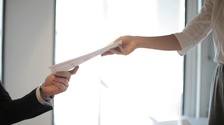It is always fun to learn a new language; however, some languages are more complex than others. Take Japanese for example, one of the many languages people are interested in learning, yet, they hold back because it seems hard to learn, let alone decipher what each character represents. The writing system for Japanese consists of Kanji(漢字) and kana. Kana is further split as Hiragana and Katakana -- think of them as the alphabets (ABCs) for Japanese. Alternatively, Japanese Kanji is an entirely different concept which I’ll explain in depth below.
Why Three Alphabets?
At first glance, you might think that having three separate alphabets in a language appears extremely redundant, until you know some of the backstory behind all of this. Katakana is used to write foreign loan words and sounds, while Hiragana is used for grammatical particles and simple words, and Kanji is for regular Japanese words.
Japanese Kanji is influenced and adapted from Chinese characters. Each Kanji conveys an idea and are used for nouns, verbs, adjectives and adverbs. Japanese Kanji has a collection of more than 7,000 characters, with characters usually conveying double meanings depending on the context and its position written in the sentence.
Here you can see a complete breakdown of the simple English expression, ‘I like coffee’, written in Japanese.

Picture source: here
For the purpose of this article, let’s break down each alphabet system and expand on them individually.
Kana: Hiragana and Katakana
Sorry, I lied. We will be looking at Hiragana and Katakana together, then moving to Kanji next. The concept behind Hiragana and Katakana is straightforward. Each kana represents a syllable. Hiragana is the default alphabet used to write word endings, particles and other grammatical elements. Whereas Katakana is used mainly to write foreign words and onomatopoeic words: words that describe the sound of something.
Every Hiragana has a Katakana with the same sound and vice-versa. So in total, there are around 50 main syllables for each, and 100 kana overall. There are limitations in the crossover between English and Japanese writing systems. If you want to learn Japanese, especially reading and writing, the first task is to familiarize yourself with Hiragana and Katakana. Sadly, the only way is through memorization and practice. Below is a very awesome Hiragana and Katakana Chart showing you all the syllables and their sounds.

Picture source: here
As well, you should practice writing Katakana with trace sheets here. Or you can try writing them on flashcards and constantly quizzing yourself the entire range of Hiragana and Katakana until you know them by heart. Good luck! It’ll be tough, tedious, but ultimately rewarding.
Japanese Kanji
Doubling back to Kanji, remember that each Kanji consists of a character that can have two different meanings depending on the context it is written in. Japanese children will have started learning Kanji at an early stage in their schooling. More than likely, Kanji will be your biggest barrier to mastering the Japanese language. But we’re not here to deter you, we’re here to give you practical suggestions and support.
- Start with Jouyou Kanji
Jouyou Kanji 常用漢字 is simply ‘everyday Kanji’ which the Japanese government has set at 2,000 or so characters. You can see Jouyou Kanji almost everywhere and everyday in Japan.
- Stroke order when writing Kanji
If you have studied Chinese characters, then you’ll already know where I’m leading with this. Similarly, Japanese Kanji abides by a specific way of writing each character. Simply put, each character should be written in this sequential order:
- Left vertical line
- Top horizontal and right vertical in one stroke
- Curved line inside left
- Clunky line inside right
- Bottom
This may be oversimplifying things, so if you’re highly invested in making sure your stroke order is correct when writing each Japanese Kanji, then I suggest you read here for expanded instructions on stroke order.
- Reading variations of Japanese Kanji
One last thing to be aware of when reading Japanese Kanji, there are two ways of reading: On’yomi (sound reading) or Kun’yomi (meaning reading). A lot of Kanji needs to be inflected by Hiragana in Kun’yomi.
On’yomi (音読み) reading is rooted in Chinese origins and is most commonly used in compound words and numbers. Kun’yomi (訓読み) is the Japanese reading method and can be read as a separate word or used in compound words.
As a final remark, let me leave you with four tips on how you can learn the Japanese alphabet(s):
- Learn Hiragana and Katakana together
- Practice writing the characters in groups
- Use flashcards and/or tracing paper
- Pay attention to stroke order
I can understand if this is a lot to take in: three alphabets, two reading methods, 7,000 characters, and stroke order! Whew. Don’t worry, divide your tasks into smaller chunks monthly, weekly, and daily. This will take time, but all good things do. Try to review the information you have gained with a Japanese italki teacher and see if they can help point you in the right direction. 頑張って ganbatte (good luck)!
References:
Hero image by Allef Vinicius on Unsplash









